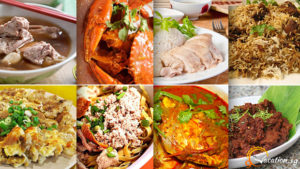 Singapore used to be a British colony, due to its strategic location. However, despite the fact that Britain had its claws in Singapore for one hell of a long time, Singapore’s population is actually mainly Chinese. The second largest ethnic group is Malays, followed by Indian, with Eurasian and other group coming in at a relatively low percentage. Due to the diverse mix of people and culture, Singapore, a relatively new independent nation, has a wealth of food option that mainly span the varieties of Asian cuisine offered all over the continent.
Singapore used to be a British colony, due to its strategic location. However, despite the fact that Britain had its claws in Singapore for one hell of a long time, Singapore’s population is actually mainly Chinese. The second largest ethnic group is Malays, followed by Indian, with Eurasian and other group coming in at a relatively low percentage. Due to the diverse mix of people and culture, Singapore, a relatively new independent nation, has a wealth of food option that mainly span the varieties of Asian cuisine offered all over the continent.
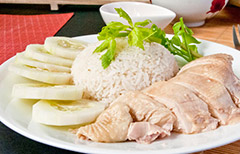
Of course, due to the large Chinese population, authentic Chinese foods with their Singaporean twists are most common, but heavier Malay comfort foods and Indian cuisine also make a striking appearance, giving you a good old spice-filled tasty trail of delights to pick from.
So which foods are the best to get your mouth around? I’d certainly recommend this list, which is by no means exhaustive.
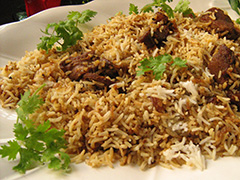
Hainanese Chicken Rice
This is the posh name for this dish which is basically chicken and rice. However, despite its quite drab, plain look, it’s mouth-wateringly delectable. The chicken is cooked by steeping it in sub-boiling chicken stock and the rice is made using an oily water with chicken stock. This means the chicken is overwhelmingly flavoursome and the rice is a little more stodgy and sticky.
Recommended:
Tian Tian Hainanese Chicken Rice at Maxwell Road Hawker Centre
Mutton Biryani
Another Indian dish, you can find this everywhere in Singapore, but mainly in Little India. Biryani varies wherever its served an Singapore has loads of different version originating from various places in India. Mutton Biryani is usually goat or sheep which is very tender due to it being marinated in spices and sauce for a long time. The marinade is usually made up of cardamom, ghee, nutmeg, mace, cloves, pepper, cinnamon, bay leaves, mint, coriander, onions, ginger and garlic. It has what food enthusiast may call, a complex taste. It’s served with rice, often coloured with saffron. It’s definitely worth a try but it’s extremely filling so make sure you stock up when you’re running on an empty stomach!
Recommended:
Jaggi’s Northern Indian Cuisine
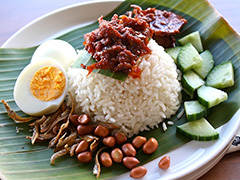 Nasi Lemak
Nasi Lemak
Nasi Lemak is a rice dish from Malaysia. It looks like a lovely little plate of treats as the rice is popped in the middle surrounded by a variety of small piles of finger foods. The rice is cooked in pandan and coconut milk so it’s slightly sweet. Around the edges of the dish, you’ll usually get peanuts, cucumbers, anchovies (most likely dried), some form of curry, and sambal belecan. Sambal belecan is a type of chilli jam condiment which is delicious when eaten with the rice. This is a nice light dinner which sort of reminds me of picking and choosing form an elaborate exotic buffet.
Recommended:
Selera Rasa Nasi Lemak at Adam Road Food Centre
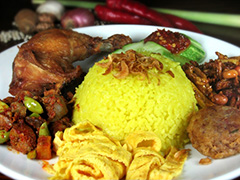 Nasi Kuning
Nasi Kuning
The thing I like most about Nasi Kuning is that it’s an excitingly colourful dish. Most of us eat with our eyes and this draws attention to itself. The flavours don’t let it down either. The term means yellow rice because it’s mixed with turmeric (which colours the rice), and also mixed with coconut milk. It’s usually served with shredded omelette, a relish made from shredded coconut and spices, shrimp crackers, cucumber, potato fritters, and fried anchovies and peanuts. It’s another nice little array of tastes for you to sample.
Recommended:
Violet Oon’s Kitchen
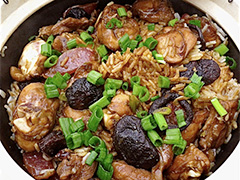
Clay Pot Chicken
This is chicken, cooked and served in a clay pot. It’s that simple. Usually the clay pot of wonder includes Chinese sausage to add a sweet taste and crisp vegetables to add a crunchy texture. Dry salt fish is usually added. Do not be scared by the thought of dried fish, it’s oddly delicious and it adds great flavouring to the overall sauce, which is mainly made up of dark soy sauce.
Recommended:
Lian He Ben Ji Claypot Rice at Smith Street Food Centre
Chok (Porridge)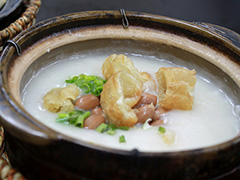
Chok is a savoury porridge, also mostly served for breakfast. It originated in China but is served all over South East Asia. It is rice as a porridge mixture, and often it is served plain for you to add your own sauces. However, I recommend finding a chicken one. It’s like a hearty chicken soup with bits of meat floating in it and an overwhelmingly delicious chicken flavour! Most versions of this dish also contain garlic and a little cabbage as well to add a little more zest and a little more oomph.
Recommended:
Zhen Zhen Porridge at Maxwell Road Hawker Centre
Bak Chor Mee
Bak Chor Mee is a form of Mee Pok, which is a Chinese noodle dish. This one is dry (meaning there’s no soup involved), and is usually pork or mincemeat based. It usually includes meatballs, slice stewed mushrooms, and pieces of deep fried lard. The lard is crispy which gives a nice change in texture form the soft, sloppy noodles. Another great comfort food, this one also isn’t particularly healthy but is scrumptious!
Recommended:
Ah Kow Bak Chor Mee at Hong Lim Food Centre
Char Kway Teow
This dish is actually a national favourite. It’s seen all over Asia, namely in both China and Malaysia, but has become something of a signature in Singapore. It literally means ‘stir-fried rice cake strips’ in Malaysian and that’s because the main ingredient in the dish is flat rice noodles. Although the texture is a little sloppy due to the noodles, the prawns give a lovely crunch to balance this out, along with bean sprouts, Chinese chives, egg, soy sauce, chilli, belachan. Despite its yummy taste, be aware that it’s not very good for you! It’s fried up in pork lard which is a big alert signal for your arteries!
Recommended:
Lao Fu Zi Fried Kway Teow at Old Airport Road Food Centre
Wanton Mee
Wantons are notoriously Chinese and are little sacks of gooey pastry, filled with all manner of meaty of fishy treats. In this dish, they’re usually filled with prawns or pork. The ‘Mee’ part refers to the noodles in the dish. In Singapore is can be served dry or in a broth, but the dry version is more popular. It’s usually cooked up with kale or other leafy vegetables giving it a nice earthy undertone and a little more texture.
Recommended:
Ji Ji Wanton Mee at Hong Lim Food Centre
Lor Mee
Lor Mee is another Chinese noodle dish. This one is made up of big, flat, yellow egg noodles. These are accompanied by fish cakes or wantons filled with either pork or prawns. The whole dish is dressed in thick, starchy gravy, made up of corn starch, eggs and a variety of Chinese herbs and spices. Most people serve this with half a boiled egg in it, and add vinegar and chilli to add an extra kick.
Recommended:
Xin Mei Xiang Lor Mee at Old Airport Road Food Centre
Kueh Chap
Kueh Chap is a salty meat soup with a mixture of different pork parts with broad rice sheets. Kueh means cake and chap “mixed”. The secret of this dish is its meat components: pork belly, skin, ears, tongue, intestines, stomach and lean. Other ingredients include dark soy sauce, hard-boiled egg and tau pok. It can be associated with Bak Kut Teh as its broth is very herbal too, if you are familiar with Singaporean cuisine. If you are a duck meat lover just ask the chef to add some braised duck meat.
Recommended:
Guan Kee Kway Chap
Tang Hoon
Back to the noodle dishes here, ‘tang hoon’ are a type of noodles, often called ‘cellophane noodles’. That’s mainly due to their glassy colour and bouncy texture. They’re a far healthier choice than yellow noodles as they don’t have the same wheat content/calorific value. However, this dish does come fried, so that’s a few points knocked off the health chart. You’ll usually find them fried with shallots, green vegetables, and mushrooms, in a thick oyster sauce for a sweet/salty flavour. Take it from me; they’re a nice change from heavy noodle dishes that seem to fill your tummy after five bites.
Recommended:
Yung Sheng (Famous for Crayfish Tang Hoon) at Taman Jurong Market & Food Centre
Curry Chicken Noodles
In my mind, this dish seems to be a complete amalgamation of all the different cultures of food blending in Singapore. Curry is from India and Malaysia, with noodles from China. It’s like a soupy-curry as it’s slightly more watery than regular curry, so that it’s easier to eat. The noodles are yellow noodles, adding a little heaviness to the dish, but the bouncy tau poh (it’s a type of tofu), and the potatoes round it off as a ‘good square meal’.
Recommended:
Heng Kee Curry Chicken Noodles at Hong Lim Food Centre
Mee Siam
Siam means Thailand. Mee means noodles. Noodles Thailand. It’s a noodley dish using thin rice noodles or vermicelli, which are extremely common in Thailand. These noodles are fried up with prawns, bean sprouts, garlic, chives, and an extreme overindulgence of chillies. It is usually served on an omelette and can either be dry or with a thick gravy. Although dry is probably more popular in Singapore, the gravy is worth trying. It’s sweet and sour all at once (and extremely spicy), made up of coconut milk, soybeans, bean curd, garlic, and chilli.
Recommended:
Hajjah Mariam Muslim Food at Kovan Market and Food Centre
Soto Ayam
This is a yellow chicken soup which is simply gorgeous. It’s yellow because it has lots of tamarind in, which stains so be careful not to spill it on yourself! It comes with lontong which are compressed rice cut into small little cakes. The soup often contains a hardboiled egg, potato celery leaves, and fried shallots. Most people add a powder called koya which is made up of ground prawn crackers, fried garlic, and sambal (it’s a chilli sauce).
Recommended:
Amirah & Nur Aniqah Mee Soto at Adam Road Food Centre
Chilli Crab
This is another deceitful name. There is a little chilli in this dish but it’s not spicy at all. It’s made up of mud crab dressed in a full-bodied sweet/sour sauce made up of mainly tomatoes and chillies. The sauce is tangy and sweet, so it feels like it’s reaching out to every taste bud in your mouth!
Recommended:
No Signboard Seafood
Bak Kut Teh
Bak Kut Teh means pork rib tea. It’s not a tea, it’s a tantalising porky soup which is extremely good for. So good for you, in fact, that it’s been used as a medicinal alternative treatment for fever in Fuji for many years. It’s made of pork ribs which are stewed in the broth for many hours, making them the kind of tender where they just slip off the bone. The broth itself is made of garlic, pepper, and medicinal herbs and spices. It’s meaty, it’s good for you, it’s warming, it’s just really, really good.
Recommended:
Founder Bak Kut Teh
Curry Fish Head
The name says it all; do not expect any other meat here except the head of a fish (usually a Red Snapper fish). This is an Indian dish, hailing from Bengal, where it is still extremely popular today. The fish is prepared in a Kerala-style curry (Kerala is a region in the south of India!), meaning it’s pretty spicy. It’s usually served with okra and aubergine, accompanied by either rice or bread. A heads up on this dish, although popular in Singapore, this dish is usually not all that cheap as it is a tourist attraction.
Recommended:
Hong Guan Cooked Food at Taman Jurong Market & Food Centre
Yong Tau Foo
This is a Chinese soup dish and if you’ve ever tried Chinese soups, you’ll understand how robustly flavoured they are. Full of spices that seem to free up your sinuses, Chinese soups pride themselves on the use of meats to create flavour, and spices to enhance that flavour. This is a fish soup that contains fish balls, crab stocks, and cuttlefish, flavoured with bitter gourds and okra. There’s usually Chinese lettuce involved for a crunchy treat!
Recommended:
Xiu Ji (Ikan Bilis) Yong Tau Fu at Chinatown Complex Food Centre
Rendang
Rendang is a dish that actually hails from Indonesia, but is commonly eaten in Malaysia. It’s probably safe to say that Malaysian immigrants brought this dish to Singapore, and I can’t blame them! It’s a spicy meat dish, which can be served with all manner of meats, but beef and mutton are among the most popular. It’s warming and creamy due to the coconut milk and spices that make up the base of the sauce. However, there is so much depth of flavour on account of the tangy tamarinds, ginger and lemongrass, and the powerful spices of garlic and chilli. This is one of those dishes that seems to explode with flavour once it touches your lips. Careful though, it is hot and the spice seems to accumulate the more you eat!
Recommended:
Old Bibik’s Nasi Rendang at Lavender Food Square
Baked Fish Custards
Now, I am going to say that this one surprised me. In my extensive knowledge of cuisine, the words ‘fish’ and ‘custard’ should never be brought together. Not only clashing in genre, they’re also extremely contrasting in taste as well. Yuck. No, thank you. However, this dish is far from the custard you’ve probably met before. It’s actually savoury and mainly consists of coconut milk, spiced with garlic, ginger, chilli and other prominent Indian spices. It has a saucy texture and is served in banana leaves, resembling a kind of thick curry. It’s made up of steamed white fish, chilli, shallots, bread crumbs and egg, and despite its off-putting name, it’s actually pretty yummy.
Butter Chicken
Butter chicken is a dish that originated in India and was brought over to Singapore with the recipe handed down over the generations. The food name is a little deceiving as it actually doesn’t have much butter in it. The chicken is marinated over night so it becomes all succulent and saturated with spices. The marinade is made up of ginger, garlic paste, garam masala, lime, pepper, coriander, cumin, turmeric, and chilli. The sauce is made with a little butter, tomato puree, khoa, and a whole bunch of spices, usually including cumin, chilli, cloves, cinnamon, and coriander. This is a hearty dish and luckily, it isn’t too spicy.
Recommended:
Tandoori Restaurant
Char Siu
Char Siu is one of my favourite things ever. It’s barbecued pork, and the term ‘char siu’ refers to the way it’s cooked. It means ‘on a fork’ referring to the fact the pork is cooked on a skewer over a fire or in some kind of oven. The pork itself is seasoned in a sweet sauce that seems to tickle your tongue all over. The seasoning is made up of honey, red fermented bean curd, hoi sin, dark soy sauce, five spice, and rice wine, forming a sticky, crunchy outer coating to the juicy meat inside.
Recommended:
Fatty Cheong Roasted Meat at ABC Brickworks Market & Food Centre
Ayam Buah Keluak
This is quite a difficult dish to describe; you really just have to try it. It’s chicken with a nutty outer coating that takes an age to prepare. The nuts used are called keluak nuts and aren’t very common, especially in the western world. They’re strange because they have a type of liquid inside them that gives them they’re flavour. What’s even stranger is that these nuts/fruits are poisonous until fermented! Anyway, the preparation of the spices and nuts can take up to a day so this chicken delight usually comes at quite a high price, BUT it’s worth it.
Recommended:
Dulukala Peranakan Restaurant
Carrot Cake
Ok, so this name is a little deceiving. Most of us are familiar with the delicious dessert cake that we call carrot cake. This isn’t even close to that! In fact, it’s savoury and is made up mainly of a white radish that looks a bit like a carrot. Its real name is Chai Tao Kway (Fried Radish Cake) and it is boiled into a ‘cake’ with preserved radish and stir-fried eggs. It’s tangy and crunchy and the ‘steaming’ technique stops the stir fried eggs from being greasy.
Recommended:
He Zhong Carrot Cake at Bukit Timah Food Centre
Thosai
Thosai is one of the many Indian dishes on offer in Singapore. If you’re looking to try Indian food, get over to Little India for an authentic array of mostly Southern Indian dishes. Thosai is a must-try appetiser when you visit. It’s a dish made up of crispy Indian pancakes served with dhal and chutney. If you’re wondering what dhal is, it’s a stew-type sauce made up of shelled pulses, all mashed together and spiced.
Recommended:
Sri Vijaya Restaurant
Roti Prata
Still digging the Indian dishes, here is another one for you. Roti is a fried flour-based pancake, but it’s thicker and has more of a bready, layered texture. The most comparable food is actually a Scottish ‘buttery’, strangely enough, if you’ve ever had the pleasure to try one. It is mouth-watering and greasy and delightful and it breaks apart in your hand and mouth with an explosion of naughty, unhealthy deliciousness. It’s prepared on a flat grill, and is served, in this case, with a fish or meat based curry. You scoop up the curry on to the bread by hand, making this meal somewhat of an adventure!
Recommended:
Sin Ming Roti Prata at Jin Fa Kopitiam
Roti John
Ever thought that an omelette sandwich would be a brilliant idea? Singapore is one step ahead of you. Basically, Roti John is made from a slice of baguette, hollowed out and filled with all the makings of a good omelette. The eggs are fried first with sardines and onions and then poured into the cavernous bread. The whole thing is then flash fried together to keep it all in. This is extremely unhealthy but is probably one of the most comforting foods on offer in Singapore!
Recommended:
Selera Rasa Nasi Lemak at Adam Road Food Centre
Murtabak
Murtabak is another stuffed pancake snack sold by street hawkers. This is more often savoury than sweet, however, and its origin is a little unknown. It’s very big all over Asia, but Saudi Arabia also lays a claim to this dish as well; it’s noted to be ‘Muslim’. Usually you’ll find the pancake stuffed with mutton, garlic, egg, onion, curry gravy, tomato sauce, and sliced cucumber. It’s really filling and seems to have this mixture of different tastes that blend together, while each taste also seems to stand alone. You can also find them filled with sugar and coconut milk. I must say, the best place to find this is in the Zam Zam Restaurant opposite Sultan Mosque.
Recommended:
Singapore Zam Zam Restaurant
Rojak
Rojak is a very beloved Singaporean light, fresh and easy-to-prepare dish. This term is Malay and it means mixture of a delicious natural chaos. It is a very popular and easy to find dish in Singapore. This is a simple salad made of fruits and vegetables. Bean sprouts, tofu, greens, fried flour, pineapple, cucumber boiled potatoes, prawns fried in batter and hard boiled eggs are cut into small pieces, mixed with a sweet thick prawn sauce and lime juice. Chopped peanuts are added at the very end.
Recommended:
Hoover Rojak at Whampoa Food Centre
Pasembur
Many foreigners don’t distinguish pasembur (mamak or Indian rojak) from rojak. The difference is in the ingredients (more meat) and sauce being used. The crunchy mixture of cucumber, potatoes, bean crud, turnip, bean sprouts, prawn fritters, fried crab, fried octopus and some other sea food. The sweet and spicy nut sauce is the most popular topping for this dish and it can be served separately. The best thing about this dish is its availability to be eaten with optional extras like sausages, whole prawns, crab, squid and fish cake. It should be eaten immediately in order to feel its crunchy texture.
Satay
Satay is a world-renowned food. Basically, it is meat on a stick accompanied by an orchestra of sauces. In Singapore, you can choose from a variety of grilled meats, which include chicken, pork, beef, mutton, intestines, and tripe, which are grilled and seasoned. The sauces vary from a red sweet/sour sauce to chilli vinegar but its most commonly served with a spicy peanut sauce. I’d recommend giving the mutton a try as it’s usually the tenderest.
Ice Kacang
Ice Kacang is a dessert that’s served all over Singapore. Its origins are a little unknown because it’s similar to Japanese shaved ice, but also seems to relate to early Chinese ice-cream, so it’s a little bit of a mystery in terms of heritage. However, that doesn’t change the fact that it is utterly delectable. Originally, everyone had this shaved ice dessert served with (strangely) red beans. Now you have choice of a variety of brightly coloured and heavily flavoured sugar syrups and fruits.
Otak Otak
Now, I wonder whether this dish was so prominently tantalising, that they felt that it had to be named twice. Who knows? Anyway, this is definitely worth tucking into when you take your cuisine tour of Singapore. It’s a kind of steamed savoury cake made out of fish. It usually houses shallots, garlic and eggs as well. The whole thing is cooked up in coconut milk and spices so it becomes a stodgy cakey texture. It’s then wrapped in a banana leaf so it takes its shape and can be eaten by hand, like a savoury dinner finger-sponge! This can be found all over the places, usually sold by street food stalls of street hawkers, and may vary in terms of what is actually in them.
Mooncakes
OK, so mooncakes don’t appear all year round; in fact you can only really buy them during the Mid-Autumn Chinese festival. It’s a lunar worship festival where mooncakes are often given to family and friends as a gift as they symbolise reunion and families getting together. However, if we overlook their sentiment for a second, they’re an exquisite tasty treat. The outer layer is like a hard sweet pastry, which is filled with a sweet dense filling. Sometimes though, the filling can be savoury such as a salted egg yolk. The sweet ones are kind of akin to Portuguese egg tarts. During the Mid-Autumn Chinese festival, you can find these cakes anywhere. They’re immediately recognisable as they are either round or square, and have highly decorative patterns carved into the pastry on the top.
Kaya Toast
Kaya Toast is either a snack or a dessert. The ‘toast’ part is pretty straight forward; it’s grilled bread, the same as what we’d have for breakfast. The ‘kaya’ part is what they spread on top. It’s made up of eggs, sugar, coconut milk, and pandan. For those of you wondering what ‘pandan’ is, it’s a type of plant often referred to as the Asian vanilla. IN this case, it gives the spread a sweet, warm flavour, in the same way vanilla extract would. Unlike vanilla extract though, pandan is green and gives the spread a greenish tint.
Fried Sesame Balls
When you’re in Singapore, you should most definitely try sesame balls. They’re Chinese and despite having the appearance of being easy to make, they’re not. This is why you should try them as you’re unlikely to be able to make them yourself! They’re made up of glutinous rice flour dipped in sesame seeds and fried. They can be filled with a whole variety of fillings, usually lotus paste, red bean paste or black bean paste. They are a dessert and are most easily found around Chinese New Year. If you’re struggling to find them, they’re real Chinese name is Jin Deui.
Cendol
Cendol is a both a dessert and a drink which seems to have originated in Indonesia. Indonesians apparently think it’s called ‘cendol’, coming from the Indonesian word ‘jendol’, which means bump or bulge. The reason for this is because it’s a drink made up of coconut milk, shaved ice and sugar, with small green jelly noodles that slip up your straw and seem to ‘bump’ into your mouth. The jelly noodles are made of sugar, glutinous rice flour, and sugar. Sometimes you can add red beans and creamed corn as well. It’s a strange one but it’s worth a try!
Bak Kwa
Bak Kwa is more of a snack and is relatively similar to good ol’ beef jerky that many Americans are used to. However, unlike American beef jerky, this gem has a surprisingly sweet taste to soak up some of its saltiness. Also, it’s mainly pork jerky that’s served on this Singaporean menu. You’ll see it everywhere, all laid out, often with little taster pots for you to dip in and road test your favourite samples. It’s usually given as a Chinese New Year gift, but you shouldn’t have trouble finding it throughout the whole year.
Min Jiang Kueh
This is a pancake, technically. However, it’s thicker than your regular pancake and a lot chewier. It’s usually for breakfast but many Singaporeans eat it as a snack in the daytime as well, mainly because it has some many options in terms of fillings, on both the sweet and savoury scale. Mostly people fill them with ground peanuts and sugar for a sweet snack to start off the day, however sometimes you can find them with coconut in or red bean paste. In terms of savoury, you often find vendors offering cheese, pork lard, and other delicious paste.
Steamed Yam Cake
This dish is originally from Malaysian, and, interestingly, many Malaysians say they miss it most when they leave home, and stuff their faces with it when they return for Mum’s cooking! That’s because it really is a tasty snack. Firstly, it’s not a sweet cake like we know. It’s a steamed cake made of yams, dried prawns and rice flour. The topping is a little more sophisticated, giving the cake most of its flavour. Usually the top consists of a thick layer of dried prawns, chilli, shallots, and spring onions, all doused in a generous serving of chilli sauce. It’s a little spicy, a little fishy, and a little sweet (on account of the yams).
Chwee Kueh
This is often known as a ‘poor man’s breakfast’ but it is definitely worth a try. It can be translated to water rice cake because that’s simply what it is; it’s made of rice flour and water pressed into a bowl shape and steamed. Most often served with chilli sauce and steamed preserved cabbage, these two things pad out the filling cake with a little tangy and spicy flavouring.
Zongzi
This is most often referred to as a rice dumpling due to it being stuffed. However, I wouldn’t really call it a dumpling in the conventional sense. It’s more like small balls of glutinous rice wrapped in a bamboo leaf. Inside this ricey delight, you may find anything, which makes it more like a Christmas cracker than a meal! Some have mung beans in, some red bean paste, jujubes, Chinese sausage, pork, or even just roasted peanuts. It’s kind of luck of the draw with this one, so buy a couple and compare the different surprise treats you find inside.
Yusheng
From heavy to light, yusheng is a spritely Chinese salad made up of raw fish. I know what you’re thinking, yuck, raw fish. Never fear, however, it’s mainly salmon (apart from the odd jellyfish included). Despite being a light salad dish, it includes a total of 27 ingredients! This include, obviously the fish and jellyfish, dried shrimp, a variety of shredded vegetables, pickled ginger, sundried oranges, key lime leaves, doused in a dressing made up of chilli, peanuts, five spice, plum sauce, rice vinegar, sesame oil, and Chinese parsley. Honestly, the depth and breadth of flavour in this dish are beyond words. From the tanginess of ginger to the spiciness of chilli, from the bitterness of key lime leaves, to the sweetness of the oranges, this truly is a magnificent concoction.
Pisang Goreng
Sometimes you’ll see this called Goreng Pisang as well; it’s the same thing. Another daytime snack, it’s basically fried bananas. These deep fried bananas often come with option of being covered in chocolate, condensed milk, cheese, or jam and are so unhealthy that you’ll have to lie to yourself about having eaten one! However, there’s something about frying a banana that seems to bring out all its inner flavour so it’s definitely forgivable to have a try of these. You’ll find them all over, mostly sold by street hawkers.
Tahu Goreng
Tahu Goreng is fried tofu. It’s a pretty simple dish where the tofu is deep fried until it’s a deep, crispy, golden brown. It’s then generously drizzled in a sauce made from shallots, garlic, chillies, shrimp paste, oyster sauce, and tamarind juice. This sauce is tangy and sweet and perfectly c compliments the savoury tofu. This is the perfect snack, in my opinion for both vegetarians and meat eaters.
Kueh Pie Tee
To finish, I’m giving you a little snack, which is kind of a savoury snack but also has sweet and sour undertones. It’s like a pastry tart, but it’s filled with shredded vegetables and prawns. It’s also a little spicy as well (surprise, surprise!). The best way to describe it is by saying it’s like someone emptied a spring roll into a pastry tart casing and sprinkled chilli on top. You can find them most often from hawkers, but try your best to find ones where they have made the casing from scratch, Store bought ones are a little dry and don’t have them same buttery taste.
Teh Tarik
This one is simply tea. It’s Indian, and as we all know, Indian is renowned for its tea so it should not be missed. It’s black tea leaves served with condescended milk and evaporated milk. This is a big favourite, especially for British tourists who love their tea. I’m not sure whether the addition of milk to this tea came from British colonialism in India per se, but it does seem to have been a huge influence on the way Indians drink black tea, as opposed to other types of tea. Anyway, whatever the origins, it’s sweet, and warming, and delicious!
